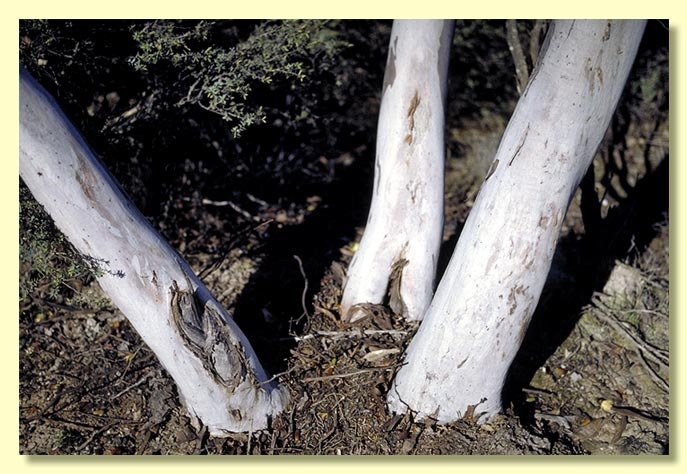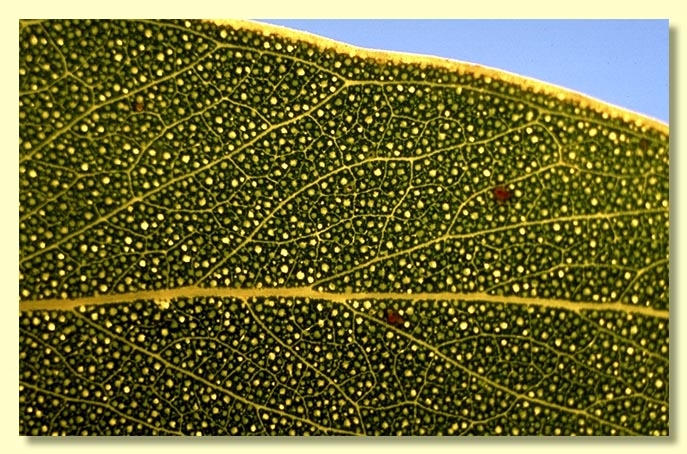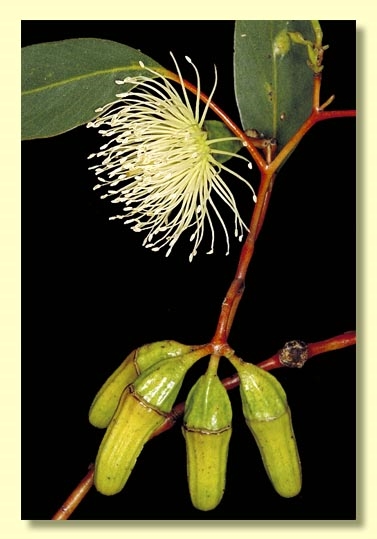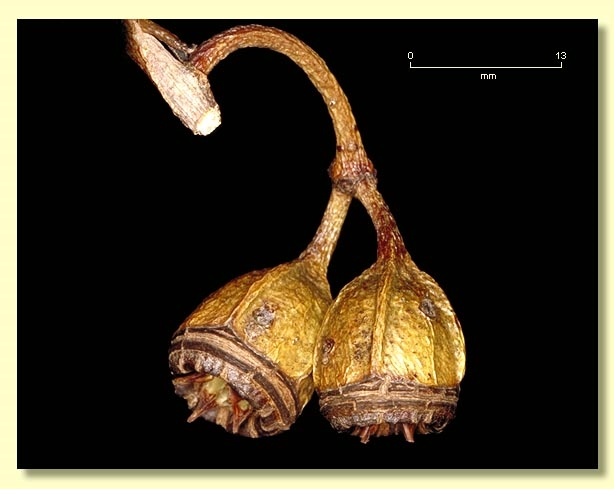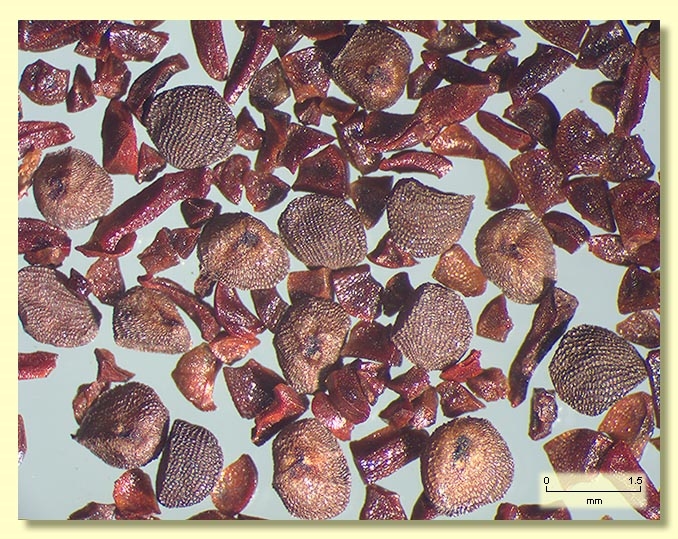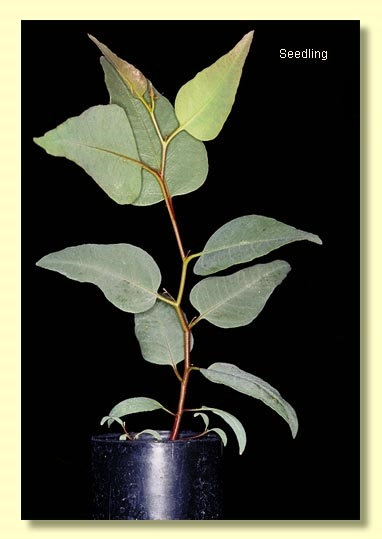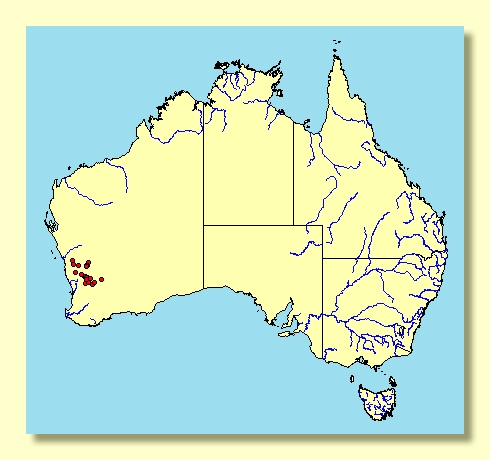Euclid - Online edition
Eucalyptus stowardii
Eucalyptus | Symphyomyrtus | Bisectae | Glandulosae | Erectae | Pedicellatae
T: Kwelkan, a few miles N of Kellerberrin, W.A., Apr.-May 1917, F.Stoward 150; holo: NSW.
Bark smooth throughout, grey over bronze to silvery pink.
Branchlets have oil glands in the pith.
Juvenile growth (coppice or field seedlings to 50 cm): stems rounded in cross-section; juvenile leaves always petiolate, alternate, ovate to lanceolate, 8–11 cm long, 2–8 cm wide, dull, bluish green.
Adult leaves alternate, petioles 1.3–3.3 cm long; blade lanceolate to slightly falcate, 6–13.8 cm long, 1.2–3.3 cm wide, base tapering to petiole, margin entire, apex pointed (often a drip-tip), concolorous, green, glossy, side-veins at an acute or wider angle to midrib, reticulation sparse to moderate, intramarginal vein present, oil glands island, large, slightly irregular.
Inflorescence axillary unbranched, peduncles narrow and only slightly flattened, spreading to down-turned, 1.5–3.5 cm long, buds 7(9), pedicellate (pedicels 0.3–1.2 cm long). Mature buds bluntly elongated-ovoid ((1.6)2.2–3.9 cm long, 0.6–1 cm wide), conspicuously finely ribbed, scar present (outer operculum falling early), operculum rounded and more or less as long as the hypanthium, stamens erect, anthers oblong, versatile, dorsifixed, dehiscing by longitudinal slits, style long and straight, stigma blunt to rounded, locules 4, the placentae each with 4 vertical rows of ovules. Flowers creamy white.
Fruit pedicellate (0.2–1.2 cm long), cylindrical to cupular with several conspicuous longitudinal ribs, 1.2–1.8 cm long, 0.9–1.5 cm wide, disc raised annular or level then descending, valves 4, held at about rim level.
Seeds blackish brown, 0.7–2 mm long, ovoid to flattened-ovoid, dorsal surface shallowly and clearly reticulate, hilum ventral.
Cultivated seedlings (measured at node 10): cotyledons Y-shaped (bisected); stems rounded in cross-section; leaves always petiolate, opposite for 2–4 nodes then alternate, deltoid to broadly ovate, 8–11 cm long, 4–8 cm wide, dull greyish green.
Flowering has been recorded in June, August and September.
A mallee endemic to Western Australia, occurring in the north-central part of the wheatbelt from Dowerin north and east to Carnamah, Wubin and Chiddarcooping. The stems are smooth and the adult leaves very glossy green.
Eucalyptus stowardii belongs in Eucalyptus subgenus Symphyomyrtus section Bisectae subsection Glandulosae because the buds have an operculum scar, cotyledons are bisected and branchlets have oil glands in the pith. Within this large subsection (ca 80 species). E. stowardii belongs to a group of mallees and mallets (series Erectae subseries Pedicellatae) recognised by the glossy green leaf surface, leaves with many oil glands but not obscuring the secondary venation, peduncles long and flattened or terete, inflorescences spreading and buds with a long operculum and erect stamens arising from a narrow staminophore.
Eucalyptus stowardii differs from its closest relative, E. diminuta, by having slightly larger, shallowly ribbed rather than weakly striate buds and broader glossy green leaves. It occupies sites of decomposed granite whereas E. diminuta occurs on rocky hillsides or breakaways of laterite, sandstone or kaolinitic rubble.
E. stowardii and E. diminuta can be distinguished from E. eremophila and E. tenera by the ribbed or striate blunt buds on more slender peduncles, and non-glazed glossy leaves with visible side-veins. E. sargentii, a species of saline depressions, differs from E. stowardii because it has smooth (non-striate), more slender buds and usually a short stocking of rough bark.


